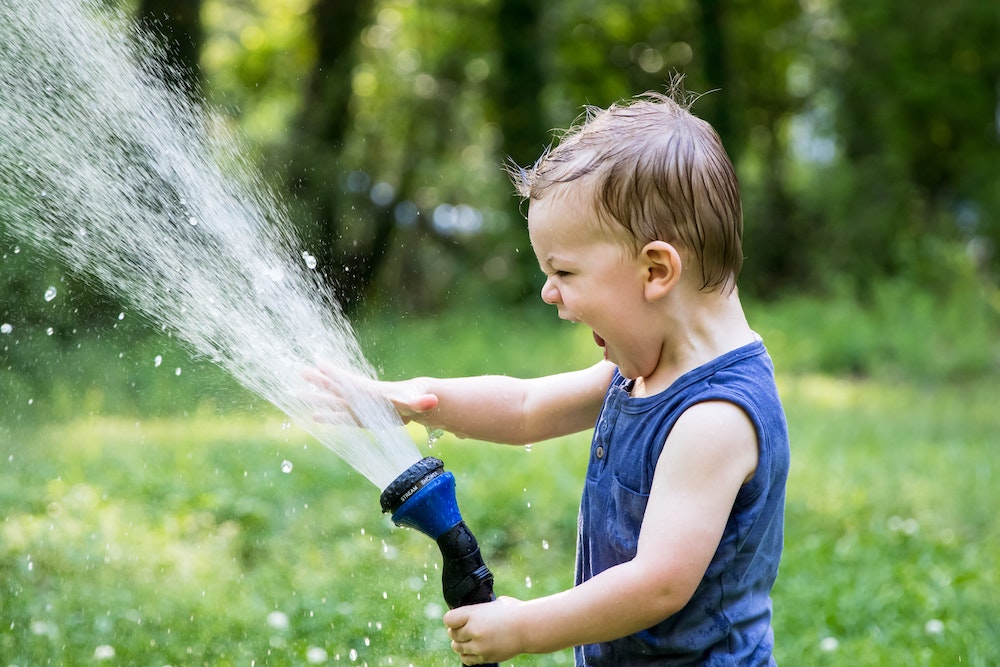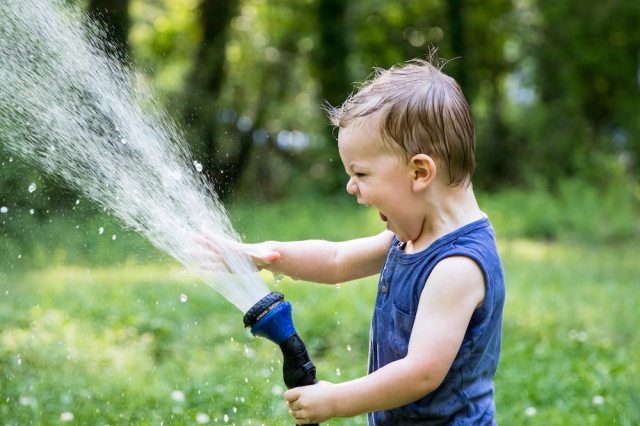
Spring is in the air, and that means it’s time to introduce my favorite toddler gardening activities! Gardening is great for kids ages 2-5 because it builds skills, gets them away from screens, and connects them with the big, wide world. Especially now, when there are fewer opportunities to get out and involved in the community, gardening can be another link in their social chain.
While it might sound exhausting to some moms, gardening with toddlers can be a lot of fun if you manage your expectations. Let’s be clear: there will be no Better Homes & Gardens cover images from your backyard. Your toddler will need to learn what they can and can’t do in the garden, and will probably make some mistakes along the way. But you’ll have something better than a pristine backyard: an occupied toddler!
Here are 7 concrete ways to get your toddler gardening that will keep them busy for at least fifteen minutes.
1. Planting
If you’re sowing plants with big seeds, call up the toddler troops. Pea, bean, squash, and sunflower seeds are the perfect sizes for little hands with limited coordination.
Start by grabbing a muffin tin and pressing it into the ground. This makes perfectly spaced indentations as a guide for your child. Have them poke one hole in each indentation (or one hole per pot if you’re gardening with containers). This will be about half the length of their pointer finger. Then they can practice putting one seed in each hole and covering it. In a few days, they’ll be rewarded with adorable green sprouts.
2. Watering
You know your kids best, so you can judge what exactly they can handle. Some toddlers might be able to use a partially filled adult-sized watering can. Others might be better suited to a toy watering can, or holding the hose with you. You can also make homemade watering cans using a milk jug with holes poked in the side. Finally, you might have a very young toddler whose best bet is a measuring cup filled and emptied over and over on some very sturdy plants.
3. Bug checks
One of the best ways to keep your garden pest-free is regularly picking bugs off your plants by hand. This is the perfect job for toddlers in the garden, especially those who love creepy-crawlies. I know my toddler just loves this job. (Well actually, she might just enjoy eating beetles.)
Teach your little one to identify good bugs like spiders, ladybugs, praying mantises. Then, learn what common bad bugs look like, including tomato hornworms, Japanese beetles, squash bugs. When you go out, bring a bucket of warm, soapy water around your garden. Every time they find one, have them drop it in the bucket.
4. Weeding
Of all the toddler gardening activities, this is the most dubious. After all, you don’t want your prized, heirloom tomato seedlings yanked up by an eager three-year-old!
I suggest only letting toddlers join your weeding team in July or later. Your veggies should be quite large by then, and the weeds are (hopefully) much smaller. Most older toddlers can follow a simple rule of “only pull the little ones.”
The other challenge with letting toddlers help weed is that they’re unlikely to have great technique. Instead of digging in and pulling weeds out by the roots, they’re likely to only yank aboveground leaves. If you’re making weeding a regular part of your daily schedule (or even just once or twice a week) this will be fine. Pulling weeds often is what prevents them from taking over.
5. Loading wheelbarrows
Sometimes, you just want to do all the weeding yourself. That’s okay, because kids can still get involved by loading up wheelbarrows. Have them follow behind you, gleefully chucking little handfuls of weeds into the wheelbarrow.
Warning: some handfuls will probably end up on you, the toddler, or other passing siblings.
6. Harvesting
Is there anything more rewarding than picking your fruits and vegetables after weeks of hard work? Get your little guys used to that joy and excitement by letting them help with the fun stuff, not just the work.
Obviously, some plants are less-suited to toddler harvesting than others. Plants that could be damaged by rough pulling are probably not a good bet for independent gathering. Toddlers should also be supervised to make sure they only pick ripe fruits.
7. Fall clean up
When the summer has passed and all that’s left of your garden is dried vines and stalks, it’s time to put your beds to bed. Toddlers are easily amused by the idea that gardens go “nighty night” for the winter and need to be tucked in, so let them help.
Have them wear those cute little gardening gloves (or snow mittens, if that’s easier) and yank up all non-perennial plants. I recommend using gloves because some common plants like squashes, cucumbers, and pumpkins, have very prickly vines.
Once everything’s out of the ground, have them help put compost on the beds. Fall is a great time to add nutrients to your garden because weeds won’t immediately grow and deplete them. Plus, the cold weather gives your compost time to fully break down and mix into the soil.
Have your little tike help you shovel 2-3 inches of fresh compost onto your beds. This job is ideal for toddlers because it requires no accuracy, serious muscles, or dexterity. If your kid can chuck their dinner off the table, they’ll do just fine with compost.
As a bonus, they get messy! (Ok, maybe that’s not a selling point…)











